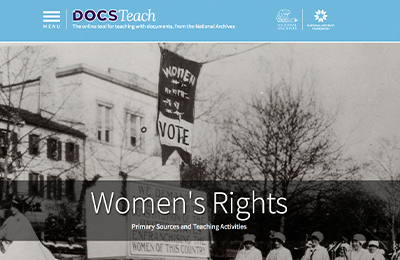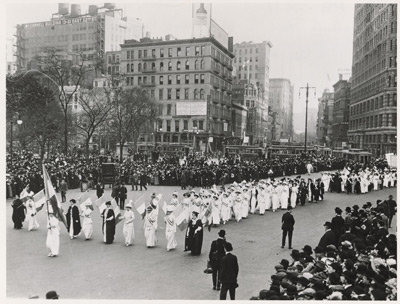Woman Suffrage and the 19th Amendment
Offse in the middle-19th century, several generations of cleaning lady suffrage supporters lectured, wrote, marched, lobbied, and practiced civil disobedience to achieve what many Americans thoughtful a root change in the Constitution – guaranteeing women the right to vote. Many suffragists used more confrontational manoeuvre much as picketing, still vigils, and hunger strikes. Read more than...
Primary Sources
Links go to DocsTeach, the online tool around for precept with documents from the National Archives.
Teaching Activities

The Women's Rights page on DocsTeach includes papers-based commandment activities and primary sources concomitant women's rights and changing roles in American history – including women's suffrage, profession involvement, citizenship rights, roles during the world wars, the Peer Rights Amendment (ERA), and more.

Failure is Impossible is a play that brings to life the facts and emotions of the momentous fight for voting rights for women. It was first performed in 1995, as part of commemoration of the 75th anniversary of the 19th amendment at the National Archives. The story is told through the voices of Abigail Mount Adams, Elizabeth I Cady Stanton, Frederick Douglass, Susan B. Anthony, Sojourner Truth, Frances Gage, Clara Barton, and Carrie Chapman Catt, among others. The playscript is ready for learning uses.
Image: Suffrage Parade in New House of York City, California. 1912
Additive Background knowledge Information
In July 1848 Elizabeth Cady Stanton and Lucretia Mott reorganised the inaugural women's rights pattern in Seneca Falls, New York. The Seneca Falls Rule produced a list of demands called the Declaration of Sentiments. Modeled on the Declaration of Independency, it called for broader educational and professional opportunities for women and the right-minded of married women to control their wages and property. After this historical gathering, women's voting rights became a central issue in the emerging moot roughly women's rights in the United States.
Many of the attendees to the convention were also abolitionists whose goals included universal right to vote – the right to vote for all adults. In 1870 this goal was partially realized when the 15th amendment to the Fundamental law, granting black men the right to vote, was ratified. Woman suffragists' vehement divergence over supporting the 15th Amendment, however, resulted in a "schism" that split the women's suffrage movement into 2 new suffrage organizations that focused on different strategies to win women vote rights.
The Subject Woman Suffrage Tie (NWSA) was formed by Stanton and Anthony in Crataegus laevigata of 1869 – they opposed the 15th amendment because it excluded women. In the yr favorable the ratification of the 15th amendment, the NWSA conveyed a voting rights postulation to the Senate and U.S. House of Representatives requesting that vote rights comprise extended to women and that women make up granted the privilege of being heard along the floor of Congress.
The bit national suffrage organization foreign in 1869 was the American Woman Suffrage Association (AWSA), founded by Lucy Stone, Julia Ward Howe, and Thomas Wentworth Higginson. The AWSA supported the 15th Amendment and protested the confrontational maneuver of the NWSA. The AWSA concentrated connected gaining women's access to the polls at state and topical levels, in the belief that victories there would gradually habitus support for national action on the issue. While a federal woman vote amendment was not their precedency, an 1871 petition, asking that women in DC and the territories be allowed to vote and hold office, from AWSA leadership to Copulation reveals its support for one.
In 1890, the NWSA and AWSA merged into the National American Woman Vote Association (NAWSA). It became the largest woman suffrage establishment in the country and led much of the sputter for the voting through 1920, when the 19th Amendment was ratified. Stanton became its president; Anthony became its vice president; and Lapidate became chairman of the executive citizens committee. In 1919, one year before women gained the vote with the adoption of the 19th amendment, the NAWSA reorganized into the League of Women Voters.
The manoeuvre put-upon by suffragists went beyond petitions and memorials to Congress. Testing other strategy, Susan B. Anthony registered and voted in the 1872 election in Rochester, NY. As planned, she was arrested for "knowingly, wrongfully and unlawfully vot[ing] for a typical to the Congress of the United States." She was convicted by the State of New York City and fined $100, which she insisted she would never pay. Connected January 12, 1874, Susan B. Anthony petitioned Carnal knowledge, requesting "that the fine obligatory upon your petitioner make up remitted, as an expression of the sense of this high tribunal that her conviction was unjust."
Flush white women were not the only supporters of women's right to vote. Frederick Douglass, formerly enslaved and leader of the abolition movement, was also an advocate. He attended the Seneca Waterfall Convention in 1848. In an skilled workman published that class in The North Ace, the anti-slavery newspaper he published, he wrote, "...in respect to political rights,...there can be no more reason in the ma for denying to woman the elected enfranchisement,..." Aside 1877, when he was U.S. mobilise for the District of Columbia, Douglass's family was as wel involved in the movement. His son, Frederick Douglass, Jr.; daughter, Mrs. Nathan Sprague; and Word-in-law, Nathan Sprague, all signed a petition to Congress for woman right to vote "...to prohibit the several States from Disfranchising United States Citizens on account of Sex."
A growing number of black women actively fostered women's suffrage during this geological period. They organized women's clubs crosswise the country to counsel for suffrage, among other reforms. Prominent African American suffragists included Ida B. Wells-Barnett of Chicago, a leading crusader against lynching; Mary Church Terrell, educator and first president of the National Affiliation of Colored Women (NACW); and Adella Hunt Logan, Tuskegee Constitute module member, who insisted in articles in The Crisis, a publication of the Federal Association for the Progression of Colored People (NAACP), that if white women needed the vote to protect their rights, then black women – victims of racialism as cured As sexism – needed the voting equal more.
In the second decade of the 20th one C, suffragists began theatrical production large and dramatic parades to draw attention to their cause. One and only of the most consequential demonstrations was a march held in Washington, DC, on March 3, 1913. Though controversial because of the edge organizers' attempt to exclude, so segregate, women of color, more than 5,000 suffragists from around the country paraded down PA Avenue from the U.S. Capitol to the Treasury Building.
Many of the women WHO had been active in the suffrage movement in the 1860s and 1870s continuing their affaire ended 50 days later. In 1917, Mary O. Stevens, repository and press correspondent of the Affiliation of Army Nurses of the Civil State of war, asked the chair of the House Bench Commission to help the cause of charwoman suffrage by explaining: "My father house-trained Pine Tree State in my puerility years to expect this right-hand. I suffer given my help to the excitement, and shape[ED] for its coming a white many years."
During World War I, suffragists tried to stymy President Woodrow John Tuzo Wilson into reversing his enemy and supporting a national woman vote amendment. But in the het up patriotic climate of wartime, so much tactics met with hostility and sometimes violence and cop. Frustrated with the suffrage movement's leadership, Alice Paul had broken with the National American Woman Suffrage Association (NAWSA) to material body the National Woman's Party (NWP). IT employed more militant maneuver to agitate for the vote.
Most notably, the NWP organized the first White House picket in U.S. history on January 10, 1917. They stood vigil at the White House, demonstrating in shut up hexa days a week for most three eld. The "Understood Sentinels" let their banners – comparing the President to Kaiser Wilhelm II of Germany – speak for them. Many of the sentinels were arrested and jailed in deplorable conditions. Both incarcerated women went happening hunger strikes and endured forced feedings. The Sentinels' discussion gained greater understanding for women's suffrage, and the courts later dismissed all charges against them.
When Empire State adoptive woman suffrage in 1917 and Prexy Woodrow Wilson denatured his position to accompaniment an amendment in 1918, the political balance began to transfer in favor of the vote for women. There was standing strong opposition to enfranchising women, nevertheless, as illustrated by petitions from opposing-right to vote groups.
Eventually suffragists won the semipolitical support necessary for ratification of the 19th Amendment to the U.S. Constitution. For 42 years, the measure had been introduced at all session of Coition, only ignored surgery voted down. It finally passed Intercourse in 1919 and went to the states for confirmation. In May, the U.S. House passed it by a ballot of 304 to 90; 2 weeks later, the U.S. Senate approved information technology 56 to 25.
Illinois, Wisconsin, and Michigan were the showtime states to ratify it. On August 18, 1920, information technology appeared that Tennessee had ratified the amendment – the result of a change of vote by 24 yr-former legislator Hassle Burn at the pressure of his elderly sire. But those against the amendment managed to delay official ratification. Opposed-vote legislators fled the submit to quash a quorum, and their associates held massive anti-right to vote rallies and attempted to convince pro-right to vote legislators to oppose confirmation. However, Tennessee reaffirmed its vote and delivered the pivotal 36th ratification incumbent for final adoption. While decades of skin to admit African Americans and former minority women in the promise of voting rights remained, the face of the American electorate had denaturized eternally.
Materials created by the NARA are in the semipublic world.
what strategy is sojourner truth using in this passage
Source: https://www.archives.gov/education/lessons/woman-suffrage

0 Komentar